January 31, 2014
As required by Section 9005 of the Elections Code, this letter
analyzes the proposal
(A.G. File No. 13‑0063) to end the existing State of California and
replace it with six new states, subject to approval of the United States
government. The text of the proposal states that it is an initiative
measure, which would amend the California Constitution and the state’s
Government Code.
Background
California’s Existing Boundaries
History of Current Borders. The current
borders of California are specified in the California Constitution and a
few other state laws. These borders resulted from: (1) an 1848 treaty
with Mexico that ceded California to the United States and (2) the
decision of delegates at California’s 1849 constitutional convention to
set the state’s eastern boundary near the crest of the Sierra Nevada
Mountains and along the Colorado River. Congress and President Fillmore
agreed to admit California to the union as a “free state” as part of the
Compromise of 1850. Proposals to split California into two separate
states were not approved at that time.
Efforts to Split California Since Statehood.
Discussions of splitting California into two or more states
continued after statehood and have emerged periodically ever since. In
1859, the Legislature passed a measure consenting to the separation of
areas south of the Tehachapi Mountains (including Los Angeles County and
San Diego County, among others) into a separate territory or state. The
measure conditioned California’s approval for this split on two-thirds
of Southern California voters agreeing to it. In an election, three out
of four of those voters approved separation. Congress, however, never
acted on the separation plan, so it was never implemented.
Since the early 1940s, some residents of far northern California have
suggested that their counties—along with a few counties in southern
Oregon—separate from the two states to create a new state called
Jefferson. Recently, Boards of Supervisors in Glenn, Modoc and Siskiyou
Counties approved measures supporting separation from California.
Relationship Between Existing State and Local Governments
This measure also contains provisions concerning the relationship
between the existing State of California and its local governments. This
section provides background on those issues.
State Reimbursements for Mandates Imposed on Local
Governments. When the state government mandates that a
local government provide a new program or higher level of service, the
California Constitution generally requires the state to reimburse the
local government. If a new law is determined to be a reimbursable
mandate, the Legislature must fund local government costs for the
mandate, suspend the mandate, or repeal the mandate. Suspending or
repealing the mandate does not eliminate the state’s obligation to
reimburse local governments for any costs incurred in prior years during
which the mandate was active, although doing so allows the state to
defer payments to future years.
Cities and Counties May Adopt Charters.
State law generally defines the roles and responsibilities of cities and
counties. The California Constitution, however, allows cities and
counties to adopt or amend charters—subject to approval by local
voters—that supersede state law on certain issues. Of California’s 58
counties, 14 currently are charter counties, including some of the
largest ones, such as Los Angeles County, San Diego County, and Orange
County. Charter cities generally have authority over their “municipal
affairs.” Although the Constitution does not define municipal affairs,
case law suggests that they include municipal elections, land use and
zoning, contracting, and budgeting. Despite this authority of charter
cities, state laws concerning city municipal affairs may be controlling
if necessary to further a significant statewide interest.
Proposal
Establishes Process to Split California Into Six New
States. This measure amends the State Constitution to
allow a statute to consent to the splitting of California into two or
more new states. The measure also amends state statutes to provide
California’s legislative consent—pursuant to the relevant section of the
U.S. Constitution—for the creation of six new states within the current
boundaries of California. The measure keeps intact existing county
boundaries and assigns each county to one of the six new states shown in
Figure 1. The measure specifies that the names of the six new states
will be Jefferson, North California, Central California, Silicon Valley,
West California, and South California. As shown in Figure 2 (see page
4), West California—including Los Angeles—would be the most populous of
the six states, with a population similar to that of Ohio. West
California’s population would be less than one-third of today’s
California. Jefferson—including the northernmost counties—would be the
least populous of the six states with 1 out of every 40 residents of
today’s California and a total population somewhat smaller than
Montana’s.
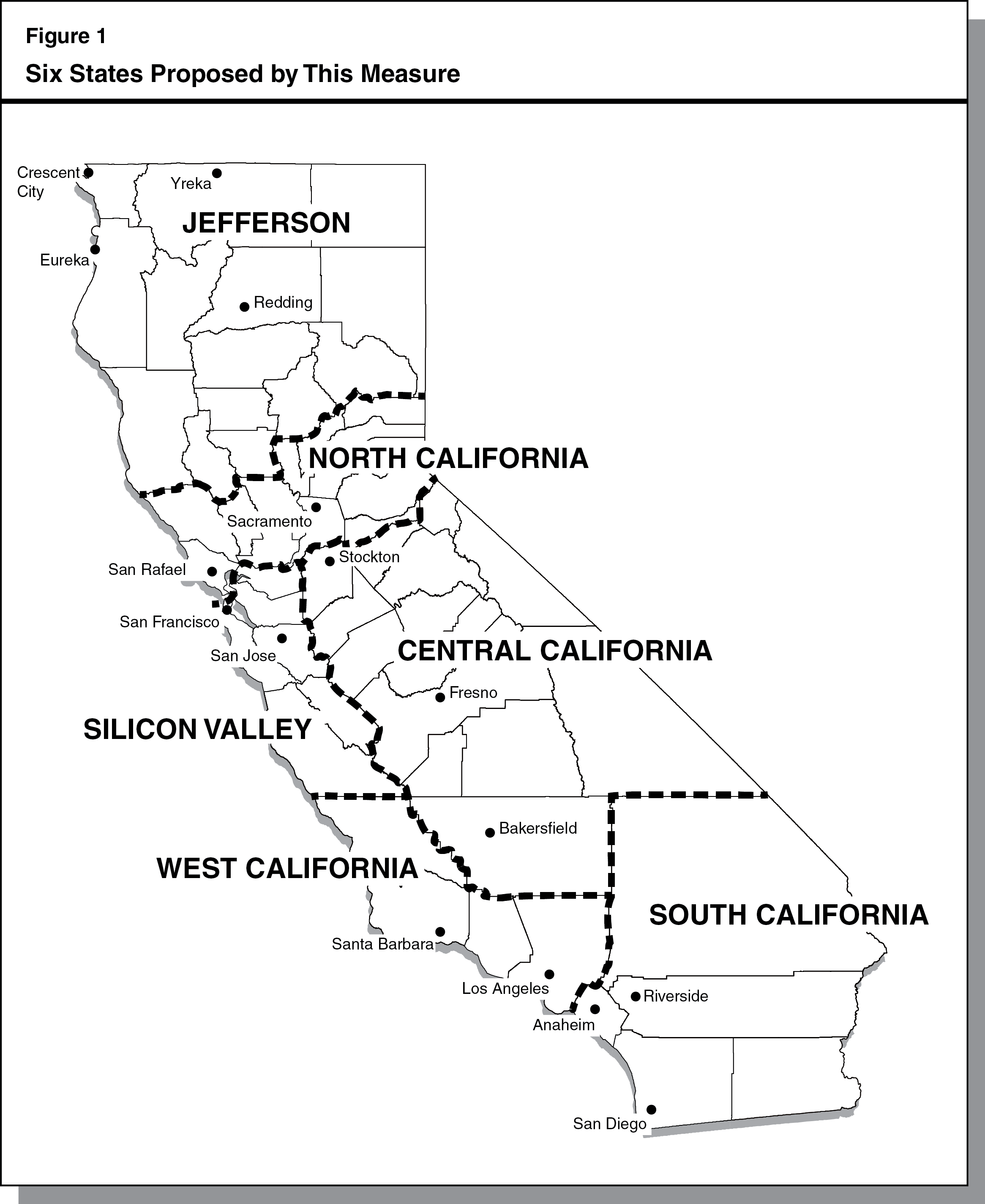
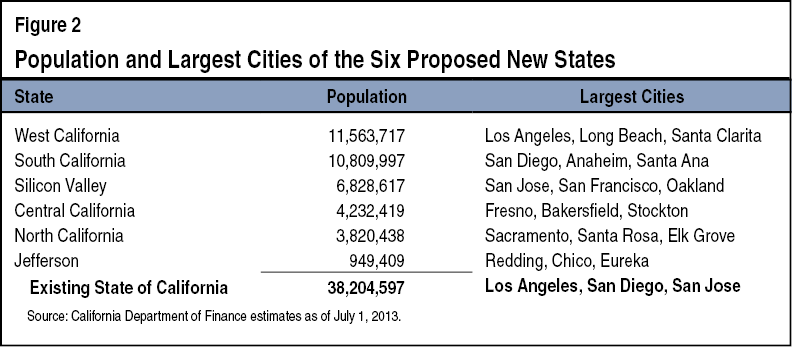
Power of Counties Over Municipal Affairs.
Effective immediately upon voter approval of this measure, the
California Constitution would be amended to allow more authority for
charter counties over municipal affairs that now may be controlled by
city governments. In cases where existing county charters do not address
such municipal affairs, voter approval of amendments to those charters
would be required. For example, a county charter could be amended under
this measure to delegate authority over municipal affairs to a regional
association consisting of several counties. In addition, the measure may
be interpreted as prohibiting the state from delaying payment of
reimbursements to counties for state mandates concerning municipal
affairs. These provisions relating to county governments would remain in
effect so long as the State of California continued to exist. If
Congress never approves the proposed plan to split California, these
provisions relating to county governments would remain in place in the
California Constitution.
Process to Implement Proposal
Procedures Specified in the Measure
Under the measure, California’s existing state government would
continue until each new state is organized and established—presumably
including congressional approval—and has its own state constitution in
place. The measure specifies a number of steps that would be undertaken
by local and state officials after approval of the measure.
Creates Board of Commissioners to Guide State Separation
Process. The measure states that a Board of Commissioners
to provide for California’s division would be created “upon enactment of
this section” (which would occur the day after the measure is approved
by voters). The measure provides for 24 commissioners: (1) 12
commissioners to be appointed by the Legislature (six by the State
Assembly and six by the State Senate) and (2) two commissioners chosen
by all of the members of county Boards of Supervisors in each of the six
new states. Each of the 24 commissioners would serve for a “term not to
exceed” two years. (While the measure requires the Legislature’s 12
commissioners to be chosen within six months after Congress approves the
creation of the six new states, it does not prohibit an earlier
selection of commissioners.)
The Board of Commissioners would be required to “settle and adjust
the property and financial affairs” between the existing state and the
six new states. This likely would require disposing of each of the State
of California’s physical and other assets—as well as splitting the
state’s financial and other liabilities—among the six new states. If the
commissioners fail to reach resolution “before the end of their terms,”
the measure states that California’s state debts would be distributed
among the new states based on population and the assets of California
within each new state’s boundaries would become an asset of that new
state. The measure requires the California Legislature to provide
financial and staff resources to the Board of Commissioners as needed.
Process to Reassign Counties Among the Six States.
Through November 15, 2017, the measure would allow any
county—subject to approval of county voters—to adopt an ordinance
allowing it to be reassigned from the state in which it is placed by
this measure to one of the other five proposed states. This could only
occur, however, if the reassigned state’s borders are immediately
adjacent to those of the county in question and if a majority of the
county Boards of Supervisors in the reassigned state approve of the
change.
Congressional Approval for State Split Plan Sought by
January 1, 2019. The measure requires the Governor of
California to transmit the state-splitting proposal to Congress for its
consideration on January 1, 2018. The Governor would be required to
request that Congress act on the proposal by January 1, 2019.
Other Steps Required Before Splitting California
In addition to the steps described above, additional steps would be
required—assuming voters approve this measure—before California could
split into six new states.
Potential Court Challenges. Litigants
likely would bring a variety of challenges to California’s separation in
federal and state courts. These challenges could involve various issues,
including ones related to the distribution of California’s assets and
liabilities, the provision of public services among the six states (some
of which are discussed later in this analysis), and constitutional
issues related to congressional approval of the new states. Court cases
related to California’s split could persist for a long time. Legal
disputes between Virginia and West Virginia, for example, concerning the
latter’s share of state debt lasted for about 50 years after West
Virginia statehood (including several cases before the U.S. Supreme
Court). In addition, a possible suit would concern whether this is an
initiative measure (as the text of this measure states) or a revision of
the California Constitution. A revision is generally broader in scope
than an initiative measure—for example, a change that substantially
alters the basic governmental framework of the state is a revision.
Under the California Constitution, revisions may be proposed only by the
Legislature or a constitutional convention.
Congressional Approval Required. Assuming
voters approve this measure, California would not be split unless the
federal government enacted a law approving the separation. The bill to
create the new states would have to be approved by a majority of the
U.S. House of Representatives and the U.S. Senate. Finally, the measure
would have to be approved by the President of the United States, unless
his or her veto were overridden by Congress.
Fiscal Effects on State and Local Governments
If approved and implemented in full, this measure eventually would
terminate tax and fee collections and spending by the existing State of
California. A specified process would divide California’s assets and
liabilities among six new states. To the extent that the new states
continue existing local governments, local entities (and the new state
governments) would face a number of budgetary, economic, and other
issues summarized in this section.
The Six States’ Different Income Levels and Tax Bases
At least initially—and perhaps for many decades after their
creation—the six proposed new states would have widely varying income
levels. The varied income levels would have important effects on each
state’s tax base. This section considers the three largest state and
local tax sources: the personal income tax (PIT), sales taxes, and
property taxes.
Significant Income Differences Among the Proposed States.
Personal income is a broad measure of the size of the
economy, which includes wages and salaries, proprietors’ income, rental
income, dividends, interest income, and transfer receipts such as
payments by governments to individuals. When measured on a per-person
(or per capita) basis, personal income data can show which areas tend to
have higher-income (generally, wealthier) or lower-income (generally,
less wealthy) individuals and households. As shown in Figure 3 (see next
page), per capita personal income (PCPI) in today’s California is
$46,477, which ranks 12th among the 50 U.S. states. Wealth in
today’s California, however, is disproportionately concentrated among
households in the San Francisco Bay Area, including Silicon Valley,
which benefits from a concentration of technology firms. For this
reason, if California is split into six states as proposed by this
measure, two of the six states (Silicon Valley and North California)
would have PCPI above that of today’s California, while the other four
states would have lower PCPI based on 2012 data.
Silicon Valley’s PCPI—$63,288—currently would rank as the highest
among U.S. states ($3,600 above Connecticut, but still below the
District of Columbia). Central California would rank as a leading
agricultural producer. Its PCPI and that of Jefferson, however, would be
notably lower than the PCPI of the other four new states. Currently,
Central California’s PCPI would rank last among all U.S. states (about
$150 below Mississippi).
The data in Figure 3 assume that no counties reassign themselves to
one of the other states as allowed under the measure. If, for example,
Marin County—just north of the Golden Gate Bridge—opted to join Silicon
Valley instead of North California, Silicon Valley’s PCPI would climb by
about $1,000, while North California’s PCPI would fall below that of
West California.
California’s PIT Base Concentrated in Bay Area.
California’s state General Fund provides most state support for
public schools, universities, health and social services programs, and
prisons. Currently, PIT is the primary tax revenue source for state
government, making up about two-thirds of the state’s General Fund
revenues. Today’s California relies upon a progressive PIT rate
structure—one in which higher-income individuals pay a higher effective
tax rate on their income—and taxes capital gains income from stock and
home sales when realized by taxpayers. In 2011, as illustrated in
Figure 4, about 28 percent of the adjusted gross income reported on
state tax returns originated from the proposed Silicon Valley state,
despite it having 18 percent of California’s total population. This is a
direct result of Silicon Valley being a higher-income area than
elsewhere in California. Owing as well to California’s progressive PIT
rate structure—in which higher-income taxpayers pay higher effective tax
rates—Silicon Valley paid one-third of all PIT assessed by California in
2011. Just as Silicon Valley has disproportionately high PIT totals,
Jefferson and Central California have lower PIT totals, with per capita
PIT assessed in those areas far below levels in the other four proposed
states.
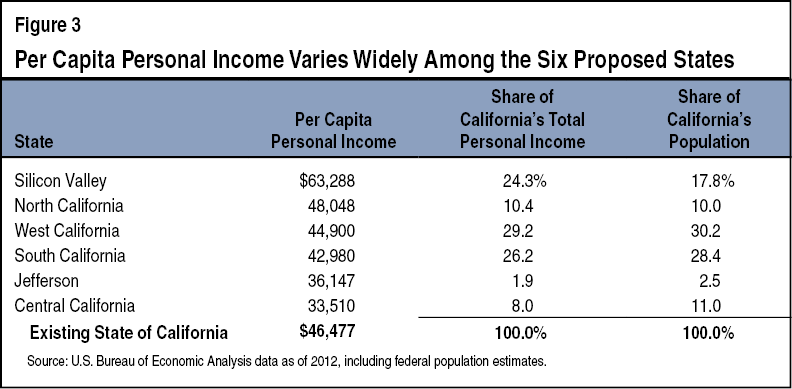
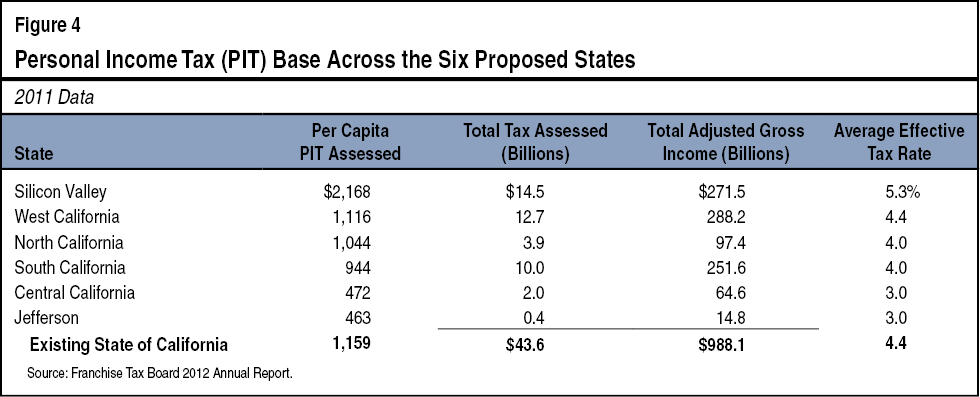
Silicon Valley Leads State in Per Capita Taxable Sales.
The sales tax is the second-largest General Fund revenue
source for the state government and is also a major local government
revenue source. California taxes most physical goods purchased in the
state, but not most services. Currently, the statewide sales tax rate of
7.5 percent generates tax revenue that is divided among state and local
government programs. (Many localities charge an additional rate on top
of the 7.5 percent statewide rate, such that the average sales tax rate
paid by California consumers currently is around 8.4 percent.)
As shown in Figure 5, Silicon Valley leads all of the proposed six
states in per capita taxable sales, while Jefferson and Central
California have less taxable sales per person than the other four
states. Nevertheless, the disparities between Silicon Valley and the
other states are not as great for this measure as they were for per
capita PIT revenues. Part of the reason for this is that lower-income
consumers spend a greater portion of their income on taxable goods. In
Central California—the region with the lowest PCPI—per capita taxable
sales total 38 percent of PCPI, the highest level for this measure of
any of the six proposed states. While South California has ranked fourth
among the six states in the income measures cited previously, it ranks
second in per capita taxable sales as a result of its residents spending
more of their income on taxable goods than any other area except Central
California. In some cases, the data in Figure 5 may be influenced by
“interstate” consumer activity—for example, by a Los Angeles County
(West California) resident purchasing a car, clothes, or large
appliances in the Inland Empire or Orange County (South California).

Per Capita Assessed Property Value Highest in Silicon
Valley. Property taxes are a major local government
revenue source and directly influence the existing state budget since
higher distributions of property taxes to schools typically reduce the
amount of money the state must provide to local school districts under
Proposition 98, a state constitutional provision passed in 1988. As
shown in Figure 6 (see next page), the existing California property tax
base is also somewhat concentrated in the Bay Area, with per capita
assessed value (AV) considerably higher in the proposed Silicon Valley
state than in any other region. Per capita AV in Central California and
Jefferson lags the other four states by a considerable margin. Housing
in these two proposed states tends to be less costly than housing in
Silicon Valley and coastal areas in Southern California.
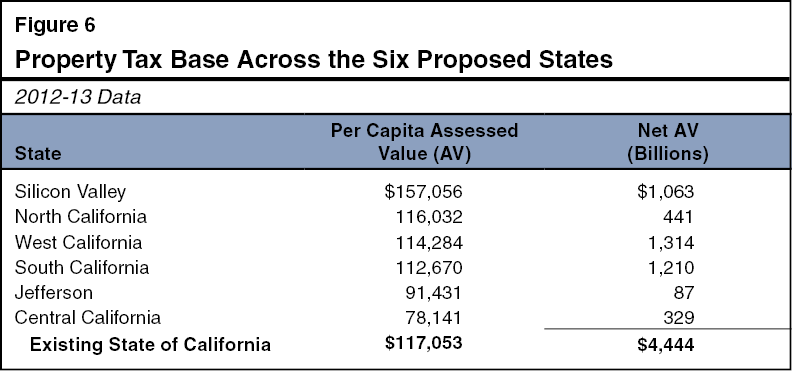
Income and Wealth Differences Would Affect Policy
Decisions. In summary, Silicon Valley would have the
highest income levels of the six proposed states and Central California
and Jefferson would have the lowest, according to the standard economic
measures discussed above. Considering the major taxes that now fund
California governments—personal income, property, and sales taxes—these
disparities in incomes (and related disparities in wealth) translate
into very different tax bases for the proposed states. Mainly because
Silicon Valley residents have higher incomes, they pay more per person
in income taxes, sales taxes, and property taxes under the existing
California tax system. By the same token, Central California and
Jefferson residents are, on average, less well-off and pay less per
person for each of these major taxes. The other three proposed
states—North California, West California, and South California—rank in
between. The regional disparities in income and wealth would affect
various fiscal and policy decisions of the six new states.
Issues Concerning Public Schools and Higher Education
According to Census data, California governments spend over
$100 billion per year on education, more than on any other area of
public services. The large majority of this money goes to fund public
schools and community colleges. Most of the rest goes to fund the
state’s two university systems, the University of California (UC) and
the California State University (CSU). The different tax bases and other
characteristics of the six states would force each to make major
decisions about these areas of public spending.
Different Regions Rely Differently on State Aid for
Schools. Figure 7 (see next page) shows the level of
per-pupil state and local property tax general purpose funding for
public schools as of 2012‑13. (This excludes certain categories of
federal and other funding.) By this measure, combined state and local
property tax funding ranged from an average of $6,330 per pupil in South
California to $6,921 in Jefferson—a less than 10 percent spread, despite
the income and wealth disparities among the regions. The reason for the
relatively small disparity in per-pupil school funding is that the
existing State of California provides state funding to supplement
resources of districts that receive relatively less in property taxes.
In other words, state funding serves to equalize disparities in property
tax wealth across school districts and regions. As a result of the
state’s funding policies, the two proposed states with the lowest level
of per-pupil property taxes—Central California and West
California—receive more state funding per pupil than the other four
states. By contrast, Silicon Valley—in which school districts receive
far more property taxes per pupil—receives far less in state funding per
student.
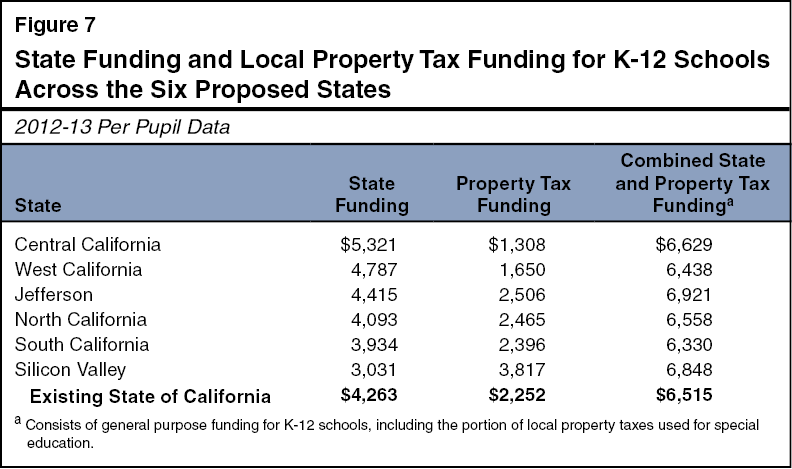
Decisions Concerning School Funding. As
shown in Figure 7, Silicon Valley’s schools already are funded
significantly from local property tax sources. As described earlier,
state tax revenues of the existing California are paid
disproportionately by Bay Area residents, such that a significant
portion of their state tax payments essentially is used to subsidize
funding for schools and other public services in lower-income regions
like the Central Valley. If Silicon Valley becomes a state, its state
tax revenues presumably would not be used to fund Central Valley, Los
Angeles, and other schools with less property tax funding. By contrast,
some of the other proposed states—especially Central California and West
California—could find themselves in the opposite situation, no longer
able to benefit from a state tax system disproportionately funded by
California’s higher-income regions.
Higher Education Across the Six States.
California’s public higher education system consists of 72 local
community college districts, the 23 campuses of the CSU system, and the
10 campuses of the UC system. If California splits into six new states,
each new state’s leaders could face a variety of choices about how to
fund and organize the campuses in their jurisdictions (see Figure 8,
next page).
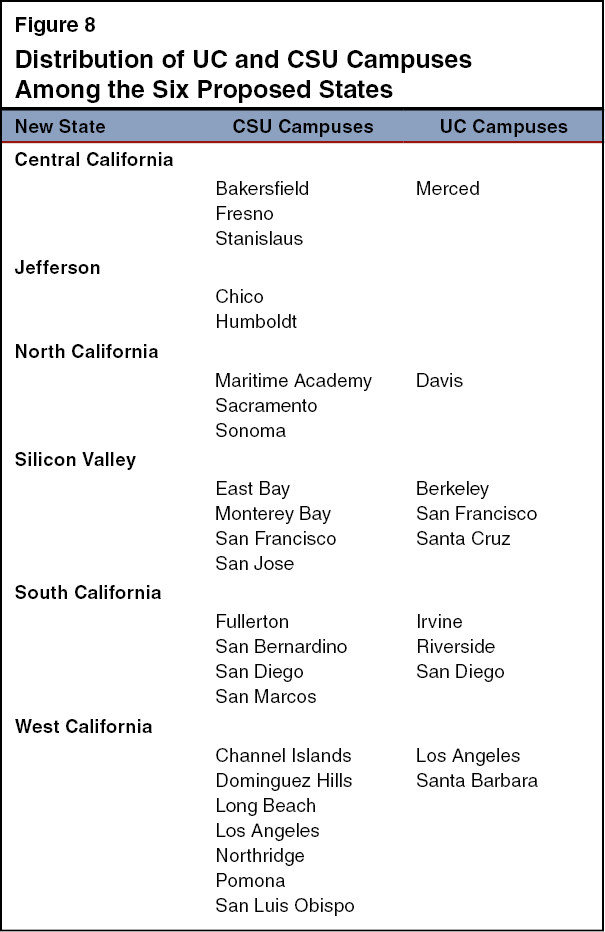
As currently stands, Central California and Jefferson do not have a
full array of professional programs, such as law and medical schools, at
public universities within their boundaries. Federal research funding
also is not evenly distributed among the six proposed states. Finally,
because the state General Fund currently provides a much larger
per-student subsidy at UC, the proposed states with more UC
campuses—such as Silicon Valley and South California—might have more
costly higher education systems, at least initially.
A 1992 State Assembly report on splitting California suggested that
the university systems—along with a few other state functions—could be
reorganized as multistate entities. Establishing multistate universities
would be an option for the Board of Commissioners (the entity
established to dispose of California’s assets and liabilities) and the
new states’ leaders, but multistate university systems would require
choices to be made—both initially and over time—about the appropriate
share of funding to be provided by each of the six proposed states,
among other issues.
Issues Concerning Health and Social Services Programs
Key Health and Social Services Programs Across the Six
States. Currently in California, state and local
governments jointly fund various health and social services programs—in
some cases, with additional support provided by funding from the federal
government. According to Census data, state and local governments in
California now spend around $80 billion per year on public welfare and
health programs, primarily to assist poor and disabled individuals in
the state. Figure 9 shows that, in 2012, the caseload of the Medi-Cal
Program—the state’s primary health care program for the poor—was not
distributed evenly across the six proposed states. For example, Central
California had 16 percent of the statewide Medi-Cal caseload, or about
1.5 times its 11 percent share of California’s statewide population.
Figure 10 (see next page) shows that per-resident spending on the
California Work Opportunity and Responsibility to Kids program—the
program that provides cash assistance and welfare-to-work services to
very low-income families—is considerably higher in Central California
than the other proposed states.
Changes in the socioeconomic status and policies of the new states
could increase the level of federal funding, particularly for the poorer
new states. Such changes in federal funding could offset part or most of
any change in state and local funding for certain health and social
services programs.
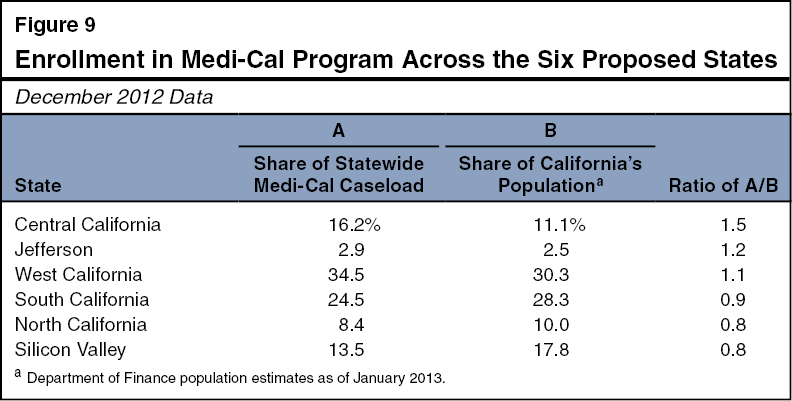

Issues Concerning Water Supply and Delivery
Complex Water System in Today’s California.
California’s existing system of water supply and delivery is
one of the most complex in the world. One reason for this complexity is
that water does not naturally appear in California where demand is
highest. Much of California’s rainfall and snowfall occurs in the north,
while much of the demand for water is in the south. Water flowing
through the Sacramento and San Joaquin Valleys—originating in part from
the Sierra Nevada snowpack—is the main source of water into the
Sacramento-San Joaquin River Delta. Two major California water delivery
projects, the State Water Project (SWP) and the federal Central Valley
Project, supply all or part of the drinking water for most Californians
from these sources. In addition, at least one quarter of the state’s
cropland uses water that flows through the Delta, and various habitats
and species rely on the flow of water into and through the Delta.
Silicon Valley and West California Are Net Importers of
Water. As shown in Figure 11 (see next page), four of the
state’s ten water basins depend significantly on water imported from
other regions of the state. These four basins, which are largely
urbanized and agricultural regions in central and coastal California,
account for a large portion of urban and agricultural water use
statewide. The state’s water basins in Figure 11 are marked by natural
boundaries, not the new state boundaries specified in this measure. In
general, however, the areas of Silicon Valley and West California
currently appear to be net importers of water from the other states
established by this measure. For example, the San Francisco Public
Utilities Commission (Silicon Valley) delivers water from the Hetch
Hetchy Reservoir in Yosemite National Park (Central California) to
2.5 million Bay Area customers. The Metropolitan Water District of
Southern California, which supplies water utilities in West California
and South California, derives its supplies from the northern part of
California via the SWP and from the Colorado River. (The Colorado River
borders only one of the proposed states: South California.)
At least three of the proposed states—Central California, North
California, and South California—contain parts of at least one water
basin that is currently a net importer and another basin that is a net
exporter. Jefferson—location of the largest artificial water reservoirs
in California—currently is a net exporter of water.

Decisions Concerning Water. The proposed
Board of Commissioners would have to consider how to divide California’s
water and related hydroelectric resources among the six proposed states.
In addition, Congress might have to consider water issues for the six
proposed new states—as well as other states bordering the Colorado
River—when considering the statehood proposal. Some issues likely would
have to be addressed in the courts. The development of multistate water
and power arrangements seems likely after California’s split into six
states. The details of these arrangements—their organization, their
funding, and the disposition of current water and power supplies—would
depend on decisions by all of these entities and the new states’
leaders.
Issues Concerning Prisons
Distribution of Prison Beds Among the Six Proposed
States. Currently, certain higher-level felons—generally,
those with a current or prior conviction for a violent, serious, or sex
offense—are sentenced to one of 34 state prisons managed by the
California Department of Corrections and Rehabilitation (CDCR).
Figure 12 (see next page) shows that about three of every four prisoners
in the CDCR system comes from West California, South California, and
Silicon Valley. These three areas combined, however, currently house
only a little more than one-third of the state’s prison inmates. By
contrast, only about one of every four prisoners comes from Central
California, North California, and Jefferson, while these three states
currently house over 60 percent of the state’s prison inmates. Prisons
in Central California alone house nearly 40 percent of CDCR inmates. The
Board of Commissioners would have to consider these issues when making
decisions about prison facilities near the time of statehood, and these
issues could affect decisions by the new states’ leaders over the long
term concerning prison operations, prison funding, and criminal justice
policies generally.
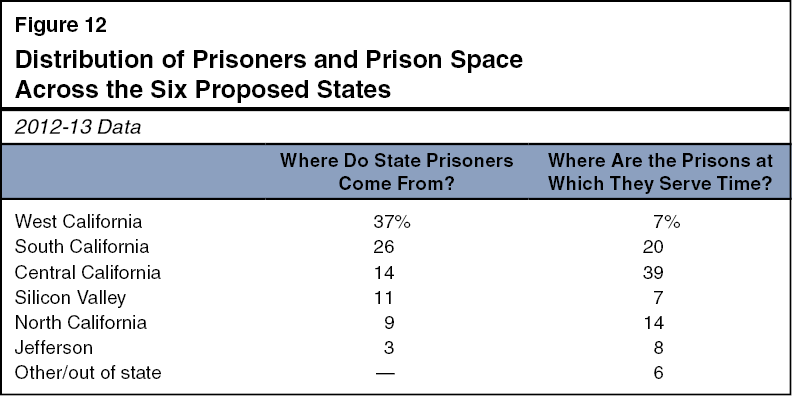
Other Issues
Outcomes Would Depend on Decisions Made by New States’
Leaders. For all of the issues described above, the
effects that California’s split would have on the new state and local
governmental entities would depend on decisions made by the Board of
Commissioners, the new states’ leaders, Congress, and, in some cases,
the courts. In addition to issues related to education, health and
social services, water, and prisons, the new states’ leaders would have
to make decisions concerning many other issues that could affect public
spending, such as:
- The new states’ tax structures, including whether to continue
the provisions of California’s Proposition 13 (1978).
- Laws and regulations concerning environmental quality and
economic development.
- How to finance transportation and other infrastructure and
whether to complete California’s planned high-speed rail system as a
multistate system.
- How to compensate public employees—including their health and
retirement benefits—and how to address unfunded liabilities of
California’s existing public employee retirement plans.
- Laws related to marriage and families.
- Various other policies related to criminal justice and public
safety, including ones concerning gun ownership and use.
Decisions Could Result in Demographic and Economic
Changes. The decisions made in all of the areas discussed
in this analysis could result in changes to the six states’ demographics
and economy, both initially and over time. For example, differing
policies could result in migration or different settlement patterns
initially. Over the longer term, the states’ economic development and
other policies could alter their respective economies. The exact nature
of these changes, both initially and over time, is unknown.
One-Time Costs to Transition From One State to Six New
States. The State of California and the six new state
governments, collectively, would have to pay various one-time costs in
the decade or so after approval of this measure. For example, the
measure requires funding the work of the Board of Commissioners, which
could total tens of millions of dollars per year in some of the years
soon after this measure’s passage. In addition, some of the new states
could choose to spend money on new buildings, such as new state
capitols, to house their new state governments in the early years after
congressional approval of their statehood. Depending on decisions made
during the transition period, some of these costs could perhaps be
offset by selling existing State of California buildings. These one-time
costs would be minor compared to the other long-term public spending
changes likely to result from the creation of the new states.
Summary of Fiscal Effects
This measure would have the following major fiscal effects:
- If the federal government approves the proposed creation of six
new states, all tax collections and spending by the existing State
of California would end, with its assets and liabilities divided
among the new states.
- Decisions by appointed commissioners and elected leaders would
determine how taxes, public spending, and other public policies
would change for the new states and their local governments.
Return to Initiatives
Return to Legislative Analyst's Office Home Page